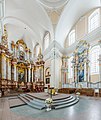Church of St. Casimir, Vilnius
- View a machine-translated version of the Lithuanian article.
- Machine translation, like DeepL or Google Translate, is a useful starting point for translations, but translators must revise errors as necessary and confirm that the translation is accurate, rather than simply copy-pasting machine-translated text into the English Wikipedia.
- Consider adding a topic to this template: there are already 284 articles in the main category, and specifying
|topic=will aid in categorization. - Do not translate text that appears unreliable or low-quality. If possible, verify the text with references provided in the foreign-language article.
- You must provide copyright attribution in the edit summary accompanying your translation by providing an interlanguage link to the source of your translation. A model attribution edit summary is
Content in this edit is translated from the existing Lithuanian Wikipedia article at [[:lt:Vilniaus Šv. Kazimiero bažnyčia]]; see its history for attribution. - You may also add the template
{{Translated|lt|Vilniaus Šv. Kazimiero bažnyčia}}to the talk page. - For more guidance, see Wikipedia:Translation.
The Church of St. Casimir (Lithuanian: Šv. Kazimiero bažnyčia, Polish: Kościół Św. Kazimierza) is a Roman Catholic church in Vilnius' Old Town, close to the Vilnius' Town Hall. It is the first and the oldest baroque church in Vilnius, built in 1618.
The construction of the church began in 1604[1] in memory of the holy prince Saint Casimir. It was built by the Jesuits with funding by the Great Chancellor of the Grand Duchy of Lithuania Lew Sapieha, Voivode of Vilnius Mikołaj Krzysztof "the Orphan" Radziwiłł, and other nobles.[3] It is traditionally assumed that the corner stone (which can be seen on the façade wall) was pulled into the city by procession of 700 Vilniusites from the Antakalnis hills.[3] The construction was finished in 1616, and the interior design completed in 1618.
The Church of St. Casimir is one of the earliest exemplary Baroque buildings in the city. Its spatial composition and facade were designed along the line of the famous Il Gesù church in Rome.[2] The shape of the building was modeled after the churches in Kraków and Lublin, with additional towers.[4] The author of the design was Jan Frankiewicz,[4][1] a pupil of architect Giovanni Maria Bernardoni.
In the middle of the 18th century the church was reconstructed by architect Thomas Zebrowski. Under his supervision a stepped lantern cupola with a crown was erected. This large and impressive cupola is unique in the entire region of the former Grand Duchy of Lithuania. Under Russia's occupation the church of St. Casimir was converted into a Russian Orthodox church. In 1915 Vilnius was occupied by the Germans and the church was converted into the Evangelical Lutheran prayer house of the Vilnius Garrison. In 1919 the church of St. Casimir was returned to the Catholics, but was damaged again during the Second World War, closed down and in 1963 converted into a Museum of Atheism. The church was reconsecrated in 1991.
The church is known for excellent acoustics and organ concerts with renowned international musicians.[5][6][7]
Gallery
- Tower (rebuilt in 1942)
-
 Main altar
Main altar -
 Interior
Interior - Side altar
-
 Interior
Interior - Organ
See also
References
- ^ a b c Aleksandravičiūtė, Aleksandra (2015). "Sacred Spaces". In Iršėnas, Marius; Račiūnaitė, Tojana (eds.). The Lithuanian Millenium. History, Art and Culture. Vilnius Academy of Arts Press. p. 253. ISBN 978-609-447-097-4.
- ^ a b Krasny, Piotr (1999). "Architecture in Poland 1572-1764". In Ostrowski, Jan K. (ed.). Land of the Winged Horsemen: Art in Poland 1572-1764. Yale University Press. p. 87. ISBN 978-0300079180.
- ^ a b "Vilniaus jėzuitų profesų namai ir Šv. Kazimiero bažnyčia". vienuolynai.mch.mii.lt (in Lithuanian). Retrieved 6 March 2021.
- ^ a b Betlej, Andrzej (2012). "Jesuit Architecture in Polish-Lithuanian Commonwealth in 1564–1772". In Álvaro, Maria Isabel (ed.). La Arquitectura Jesuítica. Actas del Simposio Internacional. IInstitucion Fernando el Catolico. pp. 290–291. ISBN 978-84-9911-158-2.
- ^ "Vargonų muzikos mylėtojus kviečia Šv. Kazimiero bažnyčia". elta.lt (in Lithuanian). Retrieved 29 August 2020.
- ^ "Klasikos koncertų salė. Kristupo festivalio Kazickų šeimos sakralinės muzikos koncerto įrašas iš Šv. Kazimiero bažnyčios". Lrt.lt (in Lithuanian). 22 June 2020. Retrieved 29 August 2020.
- ^ "Šv.Kazimiero bažnyčioje - nemokami vargonų meistrų koncertai". vilniuje.info (in Lithuanian). Retrieved 29 August 2020.
Bibliography

- Venclova, Tomas (2002). Vilnius. R. Paknys Publishing House. ISBN 9986-830-48-6.

















